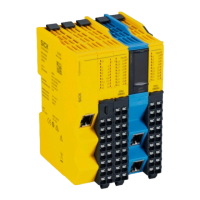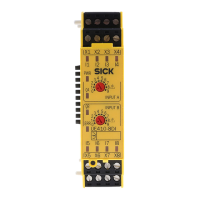Calculation of the distance L
1
f
or parallel muting
Figure 12: Example for parallel muting
1
Transported material
2
Electro-sensitive protective device (e.g., safety light curtain)
3
Hazardous area
In this example, the material moves from left to right. As soon as the first pair of muting
sensor
s (A1 and A2) is activated, the protection afforded by the protective equipment
(electro-sensitive protective equipment) is bypassed.
In the example, four muting sensors with identical response times are used. The two
muting sensor pairs are mounted symmetrically, i.e., at the same distance from the
detection range of the ESPE. Different configurations require separate consideration.
The distance L
1
is calculated using the following formula:
L
1
≥ v × 2 × T
IN muting sensor
The following prerequisites must be met:
•
v × t > L
1
+ L
3
•
L
1
< L
3
L
1
Distance between the sensors (arranged symmetrically in relation to the
de
tection zone of the electro-sensitive protective device)
L
3
Length of the material in the conveying direction
v Speed of the material (e.g., of the conveyor system)
t Configured total muting time (s)
T
IN mut
ing sensor
Response time of the slowest muting sensor used to initiate a muting sta‐
tus.
•
T
he material can either be moved in both directions or only one transport direction
can be allowed using the Direction detection configuration parameter.
•
When the sensors are arranged in parallel, the position of the muting sensors is
also used to monitor the width of the permissible object. Whenever objects move
past the muting sensors, the width must always be the same.
•
If optical sensors are used for parallel muting, pushbuttons with background sup‐
pression are typically used here to prevent a person from unintentionally activating
both sensors at the same time.
•
Prevent mutual interference of the sensors.
PROJECT PLANNING 4
8024589/2020-11-10 | SICK O P E R A T I N G I N S T R U C T I O N S | Flexi Compact
23
Subject to change without notice

